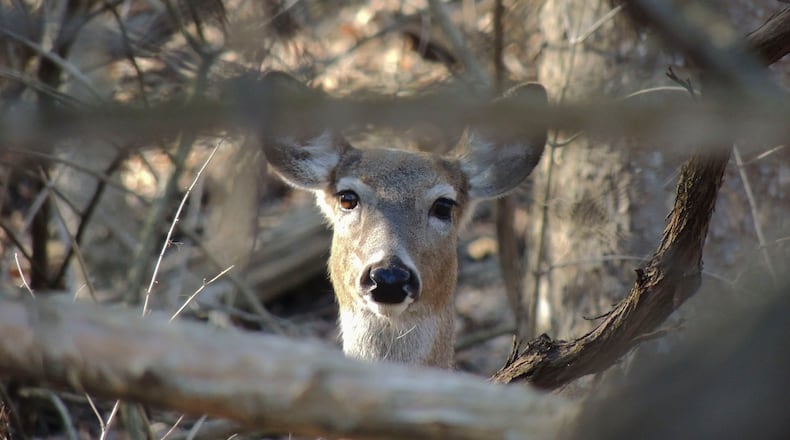“Whitetail deer are abundant in most of North America and were virtually extinct in the mid-20th century. Now, they are sort of eating anything they can. The rest is not edible or is unreachable,” Gorchov said.
He spoke of the damage to the natural areas through the loss of tree seedlings repeatedly stripped of vegetation by deer and the long-term harm to new growth of trees. He showed a slide of what appeared to be a tree seedling but which he said was a buckeye tree “browsed” so many times it only appeared to be a seedling but should have actually been much taller and bigger around.
Research work by graduate students he has supervised has produced an estimate of eight deer per square kilometer, or 20 per square mile, in the Miami natural areas. That large a number is in part due to the loss of natural predators, such as wolves, in the area creating an imbalance in the natural order, which Gorchov said they are seeking to rectify.
The research has included construction in 2010 of five deer “exclosures” 20 meters by 20 meters to keep deer out. Honeysuckle was removed from half of each one and tree seedlings did well in areas where deer were excluded and honeysuckle removed.
“Where deer are, we lose a lot more seedlings,” he told council and added in a later interview, “The enclosures were set up to answer a broad set of questions. The greatest (result) is where we exclude deer and remove honeysuckle.”
He also noted, in answer to a question from a council member, deer cause major crop problems including promoting growth of non-native earthworms.
Council member David Prytherch said he has seen a video taken in town of a herd of 16 to 18 deer foraging.
Gorchov said work of the university’s Natural Areas Committee is supplemented by an ad-hoc committee which has been studying this specific issue and possible solutions.
Gorchov referred to the city’s deer hunting provision which allows bowhunters to hunt on specific large pieces of land and said the university’s Natural Areas Committee is considering a similar plan. With hiking trails included in much of the natural areas – part of the Oxford Area Trails System, as well – he said they would set up rules for hunting to require hunters to be away from trail areas, which would also have signs posted.
“We looked at what we can do and modeled it after the Oxford plan. We need to coordinate with Oxford city and Oxford Twp.,” he said. “We will reach out to property owners bordering our natural areas.”
That will include a May 5 online Zoom meeting.
The city’s Environmental Specialist David Treleaven is a member of that ad-hoc committee and oversees the city’s annual Deer Management Program (DMP) hunt. The purpose of the city’s program differs from the emphasis of the university’s although the solution could be the same.
“Miami University is trying to preserve old-growth forests and stop damage to the forest biodiversity. In 50 to 75 years when the trees die off, there will be nothing to replace them. Oxford’s program is for public safety,” Treleaven said. “It’s public safety versus habitat.”
Oxford’s program runs along with the state’s bowhunting season dates, although Gorchov said they are looking at modifying the dates somewhat to emphasize the holiday break time when students are gone.
Treleaven said the city program started in 2009 and the effects of the annual hunt do not depend just on the number of deer harvested, but the numbers those deer will not be generating.
Since 2009 and including the 2021-22 hunt, there have been 141 deer harvested, 90 of which were donated to the Community Meal Center in Hamilton to feed less fortunate residents of the county. The largest harvest came in the 2012-13 season with 25 deer taken and 2011-12 with 20 deer harvested. Fewest taken were five in both the 2017-18 and 2018-19 hunts.
That total of 141 deer harvested since the DMP started accounted for 3,340 pounds of venison donated.
It also meant an estimated 15,136 deer were not born to further damage flowers and gardens or bolt across streets causing motor vehicle crashes.
Treleaven explained the Ohio Department of Natural Resources uses a rule of thumb showing a 70 percent increase in the deer population each year. Using that figure based on the 141 deer harvested since 2009 means the current deer population about which many people complain is potentially reduced by that many.
Gorchov said they are planning a public input meeting, via Zoom, at 7 p.m. May 5 to solicit comments and questions from city and township residents. Anyone interested in taking part in that online meeting can go to the Natural Areas web site for the link.
A lot of park systems, as well as college campuses, are dealing with deer population problems with a mix of tactics. One of those possibilities is introducing drugs to prevent deer births but that is expensive, he said.
About the Author
